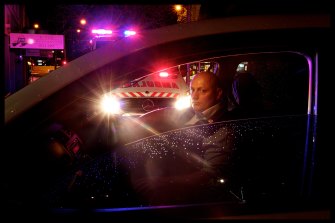Victoria’s ambulance service reported a code red in Melbourne overnight, with ambulance ramping at a major hospital and a shortage of specialised paramedics.
One paramedic described it as a “soul-destroying” situation, the union said.
An ambulance travels through Melbourne’s CBD. Credit:Paul Rovere
The escalation plan was called by Ambulance Victoria just before 2am on Sunday after extreme demand for ambulances within metropolitan Melbourne. The code red was withdrawn by 3.15am.
During an Ambulance Victoria code red, non-emergency ambulances begin responding to cases, patients are rapidly offloaded at hospitals and lower-acuity patients are referred to other services, among other measures to reduce strain on paramedics.
Sunday morning’s code red was the seventh emergency escalation called by the service this year.
Ambulance Victoria’s executive director of operational communications, Lindsay Mackay, said there was a spike in triple-zero calls at around midnight, but the sudden peak was not driven by a specific incident or cohort of patients.
Ambulance Victoria’s Lindsay Mackay.Credit:Penny Stephens
“There hasn’t been any trends really identified … it just seemed to be an increase in that surge in calls that really put pressure on us at that moment in time,” she said on Sunday.
“We say save triple-zero for emergencies … especially as it’s been a prolonged pandemic, we really want people to get that primary care and to see their specialists prior to getting to a night where you get into crisis.”
Victorian Ambulance Union secretary Danny Hill told The Age that one paramedic who worked through the code red said her 14-hour shift without a break until 5am had been “soul-destroying”.
Hill said a number of ambulance crews specialising in life support had called for help from the Mobile Intensive Care Ambulance (MICA) paramedics overnight, but there were none available.
Victorian Ambulance Union secretary Danny Hill.Credit:Simon O’Dwyer
“That means they have got a patient who is sick enough that they require not just advanced life support treatment, they actually require intensive care treatment as well … But unfortunately, the resources are so scarce when it gets this busy, but there’s often no MICA resources able to respond.”
Hill said there were 12 ambulance crews ramped at Royal Melbourne Hospital in the early hours of Sunday, with some required to stay with patients for more than four hours. Ambulance ramping is where paramedics have to wait at hospital because a patient is yet to be triaged or there are no beds in the emergency department.
Ambulances are now “absorbing the workload for the entire health system” through such ramping, Hill said, and there needs to be a national approach to turn the tide.
“I really want to see some real national engagement on this issue because so much of it sits under the federal system, which is primary care, aged care, and disability care,” he said.
“So much of that is spilling over into the ambulance arena, despite the fact ambulances are meant to do a very specific job, which is treat and transport patients with immediate emergency medical injury or illness.”
Ambulance Victoria said there had been about 170 Paramedics furloughed every day this week due to COVID-19, contributing to Sunday morning’s code red.
“We’re not immune to it, we’re just like everyone else,” Mackay said.
“So we are experiencing that as an ongoing challenge, and obviously with the flu season, it will continue to be a challenge.”
Mackay said that while she doesn’t believe Ambulance Victoria is in a precarious position, ambulance availability would continue to cause problems through winter.
“The paramedic in me steers away from say we were in crisis [when the code red was called], but what I would say is it’s definitely an ongoing, challenging environment,” she said.
“We’re managing it – like everybody is – the best we can.”
The Morning Edition newsletter is our guide to the day’s most important and interesting stories, analysis and insights. Sign up here.
Most Viewed in National
From our partners
Source: Read Full Article


